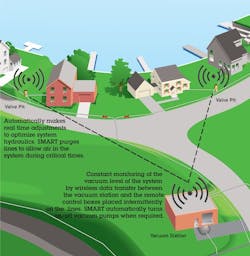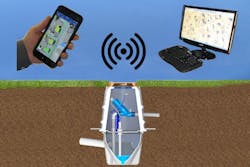Smart Sewer Investment
About the author:
John Grooms is product engineering manager for Airvac. Grooms can be reached at [email protected].
The Mesopotamians were the first to install clay pipes for sewage collection around 4,000 BCE. Since then, mankind has relied on gravity to take wastewater away from homes to be released or treated elsewhere.
Within the past 50 years sewers have gotten significantly smarter. Vacuum sewers can now transport sewage efficiently and can be monitored for problems at a central station. They are environmentally safe, easier to install and service, and they are reliable for decades.
Now, thanks to new computer and wireless monitoring technologies, vacuum sewers have become even more intelligent. Over the past several years, Airvac developed and introduced its Next Generation Vacuum Technology that includes its patented SMART (strategic monitoring for advanced remote transfer) system, wireless valve pit monitoring and vacuum pump modulation. These technologies came on the heels of other recent Airvac products, such as the HP controller and the PacVac vacuum station, a prefabricated building to house various vacuum station equipment.
Strategic Monitoring for Advanced Remote Transfer
The SMART system is the technological brain of the system that automates many things that previously required human intervention. It is easy to operate as functions can be controlled using an app on smart phones. It requires fewer people to operate and can cut overtime expenses.
Two important components of the system are the programmable logic controller (PLC) with touch screen interface located at the vacuum station, and multiple air emission control boxes mounted in an enclosure located adjacent to and connected to dedicated valve pits located strategically throughout the system. The control boxes, which are powered by either solar cells or electricity, communicate with the end of the line to monitor vacuum levels. The PLC can tell those points to emit air to clear the line out then it adjusts the vacuum level at the station. These are functions that operators used to do manually to correct various problems, such as waterlogging, but now these issues can be corrected automatically. It results in fewer call-outs, less overtime and reduced maintenance costs.
Wireless Valve Pit Monitoring
The Wireless Valve Pit Monitoring System transmits valve pit data to a central SCADA system housed in the vacuum station with the system operator having access to the data at all times on a smart device. Every valve pit in the systems transmits data by wireless radios with a proprietary frequency.
With this system, a variety of conditions at each valve pit can be monitored and alarms sent, if necessary. In addition to pinpointing the exact location of problems in real time, this also gives the system operator the ability to track trends, which can be used to make system adjustments. Operators can know the frequency of valve cycles of every valve at any time of day. They also are alerted to high sewage levels to help prevent backups into homes or if infiltration is entering the system.
Vacuum Pump Modulation
The ability to change pump speeds is another important aspect of this system. By adding modulation to a vacuum pump made specifically for use in a vacuum system, the vacuum pump can operate as low as one-third speed without sacrificing system operation. Previous pumps could only operate at full speed.
The ability to operate at lower pump speeds can significantly reduce electricity expenses.
“We’re seeing an average reduction of 25 to 35% in our monthly power bills since we upgraded to the new VFD pumps and the modulation feature,” said Jamie Tuccolo, deputy director and director of operations for the department of public services for Newburyport, Massachusetts.
By modulating the vacuum pumps, noise can be reduced by as much as 10 decibels, and pump durability and longevity are enhanced. The new VFD pumps do not require oil changes because there are no contact parts, thus saving maintenance time. Also, end-of-line vacuum levels are increased and more consistent, as the peaks and valleys within the collection line are evened out. The return on investment for upgrading to the SMART logic vacuum pump and adding the modulation feature is estimated at 2.5 to 5 years.
Preassembly vs. Design & Build
The PacVac vacuum station comes preassembled, which eliminates the need to design and build the above ground portion of the vacuum station on site. The building and related components cover a small footprint and offer an environment that is odorless, air conditioned and clean. There is rarely, if ever, an occasion where a technician comes in contact with sewage, as the vacuum system is completely sealed from the valve to the vacuum station.
New collection lines can be installed in trenches as shallow as 30 inches in depth, eliminating the need for large excavation equipment, deep trenches and dewatering. PVC collection lines are lightweight and easy to handle, and underground obstacles can be easily avoided with a slight rerouting. They do not require a change order.
If a leak or break ever occurs in a vacuum main, or if an individual valve should be stuck in the open or closed position, this will create vacuum pressure issues that could affect service. This technology can detect the location of the problem and automatically correct system imbalances. The data, which is shared to operators through smart phone applications, is stored in the cloud, where it is accessible at all times.


